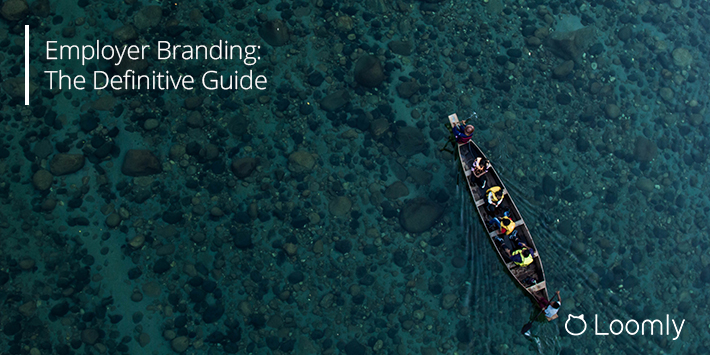Employer Branding: The Definitive Guide
If you want to bring top talent to your company, there is one strategy you need to double down on: Employer branding.
Employer branding is how you attract and engage potential employees and make the prospect of working for your business truly exciting.
By telling an authentic story about what it is like to be a part of your company and work toward your mission, you can entice candidates who think and feel and strive for the same.
In fact, 72% of employers believe employer branding has a significant impact on the hiring process, and 75% of candidates take an employer’s brand into account before even applying.
Yeah, it is that important.
In this article, we are going to show you:
- What employer branding is.
- Why it is important.
- How you can start to implement it.

Manage all your social media accounts in one place.
Craft, schedule, & auto-post content to all your social channels, then track analytics and manage interactions from a single, easy-to-use dashboard.
Employer Branding In Action: What It Is Like To Work At Google
To show you the influence of employer branding, we are going to run a little experiment.
Take a minute to close your eyes and think of everything you know about working at Google, from how the offices are laid out, through to the perks of the job and internal benchmarks.
Go on, we will wait…
Done? Cool.
If you are like the majority of people who do this exercise, you came up with some answers like:
- Slides connecting different floors
- Sleeping pods
- Open plan offices
- Funky artwork on the walls
- Colleagues in hoodies and headphones
- 20 percent time
- Moonshot goal setting
You probably also thought of words like “innovative”, “creative” and “forward-thinking”.
Chances are you have never been to Google’s offices, applied for a job there, or watched The Internship.
Yet, you already know so much about what it is like to work there.
Why is that? Because Google has spent a lot of time and effort curating an employer brand which sticks in people’s minds.
Even concepts which they no longer use, like 20 percent time, stay with us.
Their employer branding has had them at the top of the list for “Most Attractive Employer” for the best part of a decade, and that is no coincidence: it is by design.
They have tapped into the zeitgeist of what their ideal candidates are looking for in a workplace and ensured that story is told at every possible opportunity.
With all of this in mind, there is something else to consider.
It has probably also given you a strong feeling about whether you would like to work for them.
You may consider them to be the pinnacle of employment, the holy grail of companies to work for.
Or the thought of an open place office and shiny silver slides connecting different floors might be enough to make you well and truly shudder:
Either way, this is the power and impact of employer branding.
It enables people to visualize what it is like to work for a business long before they submit an application or even need a new job.
Which, in turn, allows them to decide whether they are the right person for the job.
But it also comes with a lot of other surprising benefits, too…
The Surprising Benefits Of Employer Branding
“Experts have described the current labor market as “candidate-driven.” Job seekers hold more power than employers, a trend that seems to be deepening.” – Amy Gallo, HBR
1. Give Candidates A Reason To Choose You
2011 saw the start of a dramatic shift in the job market. According to research from the Harvard Business Review:
We left an employer-driven market, where the people with positions to offer held all the cards, and moved to a candidate-driven market, where the top talent calls the shots.
In fact, the shift was so dramatic that, by 2015, recruiters saw 90% of the job market was driven by candidates:
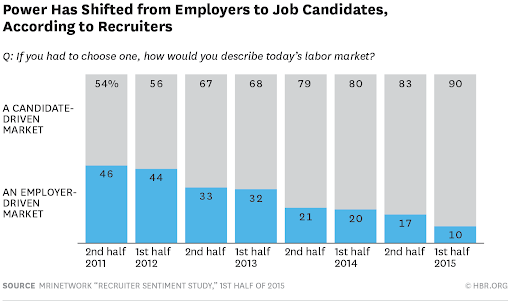
This is due to a number of factors, like:
Which gave candidates more options (and breathing room) to sit back and think carefully about their next step.
But, what does this have to do with employer branding?
Good question.
In a candidate-driven market, employer branding is your opportunity to stand out from all other companies vying for attention.
If your next job opening is the product and candidates are your customers, employer branding is the marketing strategy to entice, engage and encourage them to work for you.
2. Make The Hiring Process Smoother
Having an attractive employer brand can reduce friction in your hiring process.
A LinkedIn survey found that employers who used a branding strategy to help them recruit, hired a candidate one-to-two times quicker than before.
They also found an increase of 50% in qualified candidates applying for the role:

This can reduce the amount of administrative work and dramatically increase the chance of finding the correct candidate on your first attempt.
Which also comes with another great benefit we all love to hear about…
3. Save Money
The money-saving element of employer branding is two-fold.
Firstly, a smooth hiring process means less money spent on it: the same LinkedIn survey from the last section showed companies saved an average of 50% per employee on the cost of the hiring process.
Secondly, having a good reputation can save you money on a candidate’s wages.
Research from the Harvard Business Review found companies with a bad reputation pay an average of 10% more per employee, with the extra money being the only incentive to take the job.
Meaning, at the time of the research, a company with 10,000 employees paid at the US median wage would spend $7.6 million per year in additional wages.
The extra money often is not enough to keep those employees on board over the long term, either. Research shows that 92% of employees would consider leaving their current job for a company with a better reputation and brand.
However, if you hire a candidate as a result of your employer branding, you could be one of the companies which sees an average reduction in turnover of 28%.
Having a good employer brand, then, could save you lots of money.
4. Engage Your Current Employees
Employee engagement plays a big part in employer branding.
As you will see later in this article, telling employee stories and having them contribute to your brand has a vital role in how your brand is perceived.
The more engaged your employees are — and the more they feel appreciated — the better their relationship with their job, and the more likely they are to stay in the company.
“Good employer branding attracts better candidates, which in turn leads to employees that are more apt to work for your company, and love working with you” – Sara Pollock, Clear Company
The 4 Pillars Of Employer Branding
Pillar #1: A Clear Sense Of Purpose
Employer branding starts with a clear understanding of:
- Who you are.
- What you stand for.
- Why you are doing it.
You likely already have this information in the form of a mission statement which makes up part of your company’s DNA. (If not, it is worth putting one together!)
Not that we pretend to be a role model, but here is what the actual Loomly’s Careers page looks like:
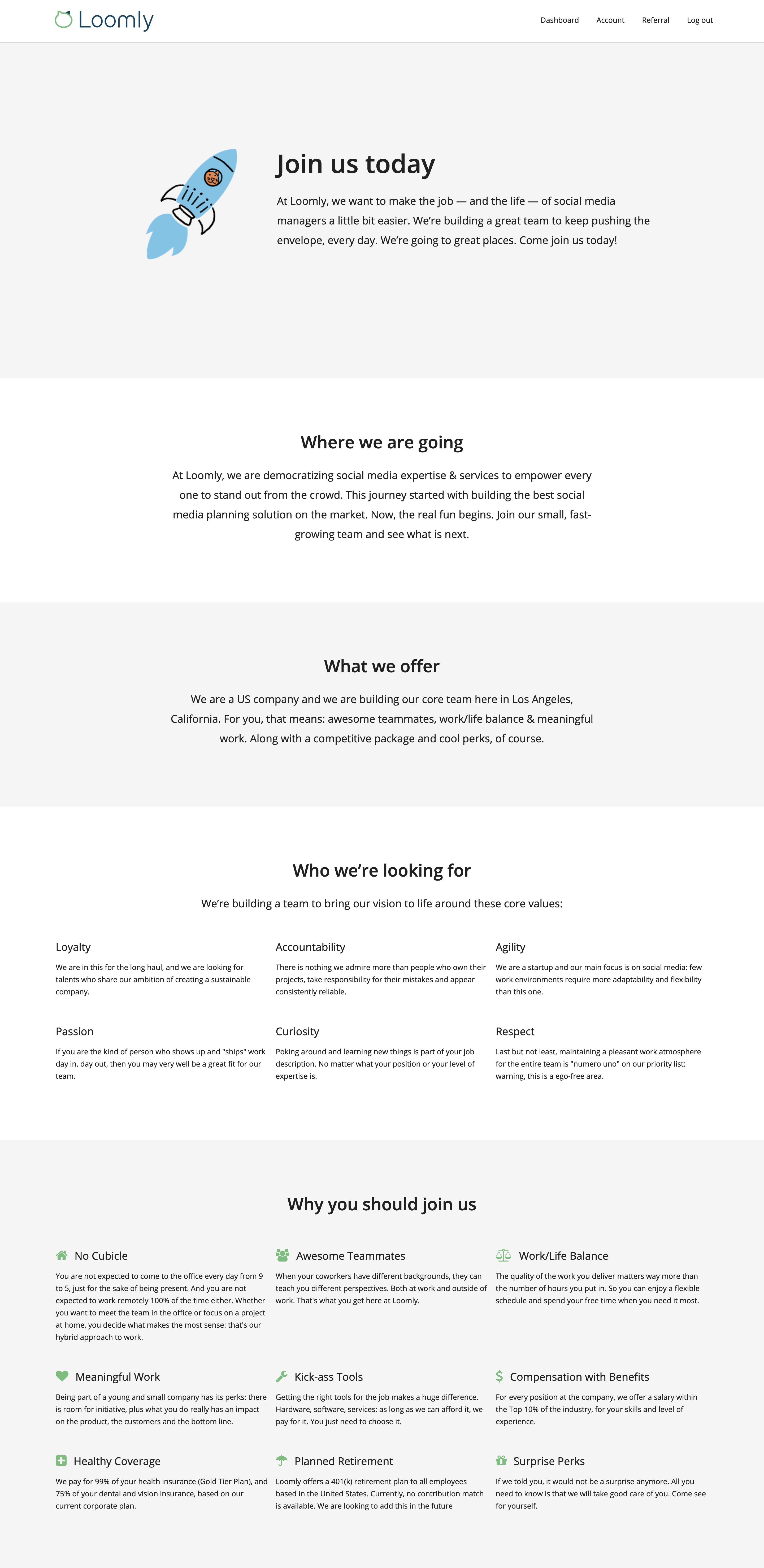
14% of candidates said a brand’s values were of the highest importance to them when choosing a job, more so than awards or accolades, such as being featured on top employer lists.
This means it is important to have your values form the foundation of your employer branding strategy, and you let their essence shine through in everything you do.
A good example of this comes from the Starbucks Jobs Instagram account, where they recently shared their mission statement:
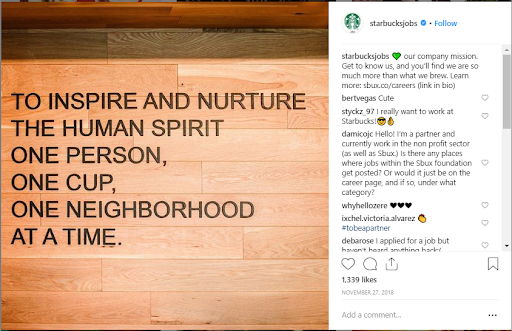
Just by reading this one sentence you have a clear idea of what Starbucks is trying to achieve, and whether you would be a good fit for the company.
If you are the kind of person who just sees coffee as a means to an end — a brown liquid to help you wake up in the morning — then this mission statement will not mean much.
But if you are the kind of person who sees coffee as an enriching experience, this mission statement is going to be infinitely more captivating.
Admittedly, this Starbucks example is a little on-the-nose; you do not need to openly share your mission statement for its underlying meaning to shine through.
Its essence should be present in everything you do, from the tone of your website’s copywriting, through to the style of image you share on Instagram. (More examples of this in a minute!)
Pillar #2: Your Employees Take Centre Stage
The next pillar of employer branding is putting the people who live and breath your mission statement at the heart of your content.
Earlier, we briefly touched on how employee engagement can increase retention. But it also plays a vital role in making your brand authentic and believable to candidates.
Surveys show potential clients trust your employees three times more than you to give an accurate account of what it is like to work for your company.
Think of it as the employee equivalent of a product review. People are more likely to trust a third party who says, “This product is great!”, and the same seems to be true for your workplace.
Having your employees at the heart of your employer brand also helps to overcome a common obstacle.
Candidates cite their number one job-seeking obstacle as not knowing what it is really like to work at a company. But, by sharing your employee’s stories and giving an insight into their daily lives, you can give them a real-world glimpse at how their future may look.
Heineken has used their employees as an integral part of their employer branding campaign over the last few years, to great success.
In an interview with Randstad, a recruitment company, their head of talent acquisition had this to say:
“Our EVP(employee value proposition) is [..] rooted in how our workforce sees Heineken and see themselves within it. When we were developing our EVP, we spoke to employees from across the organization about what they view as the defining features of the company. Three words emerged from these conversations – adventure, friends, and fame.”
You can see the results of this on the Heineken Careers website:
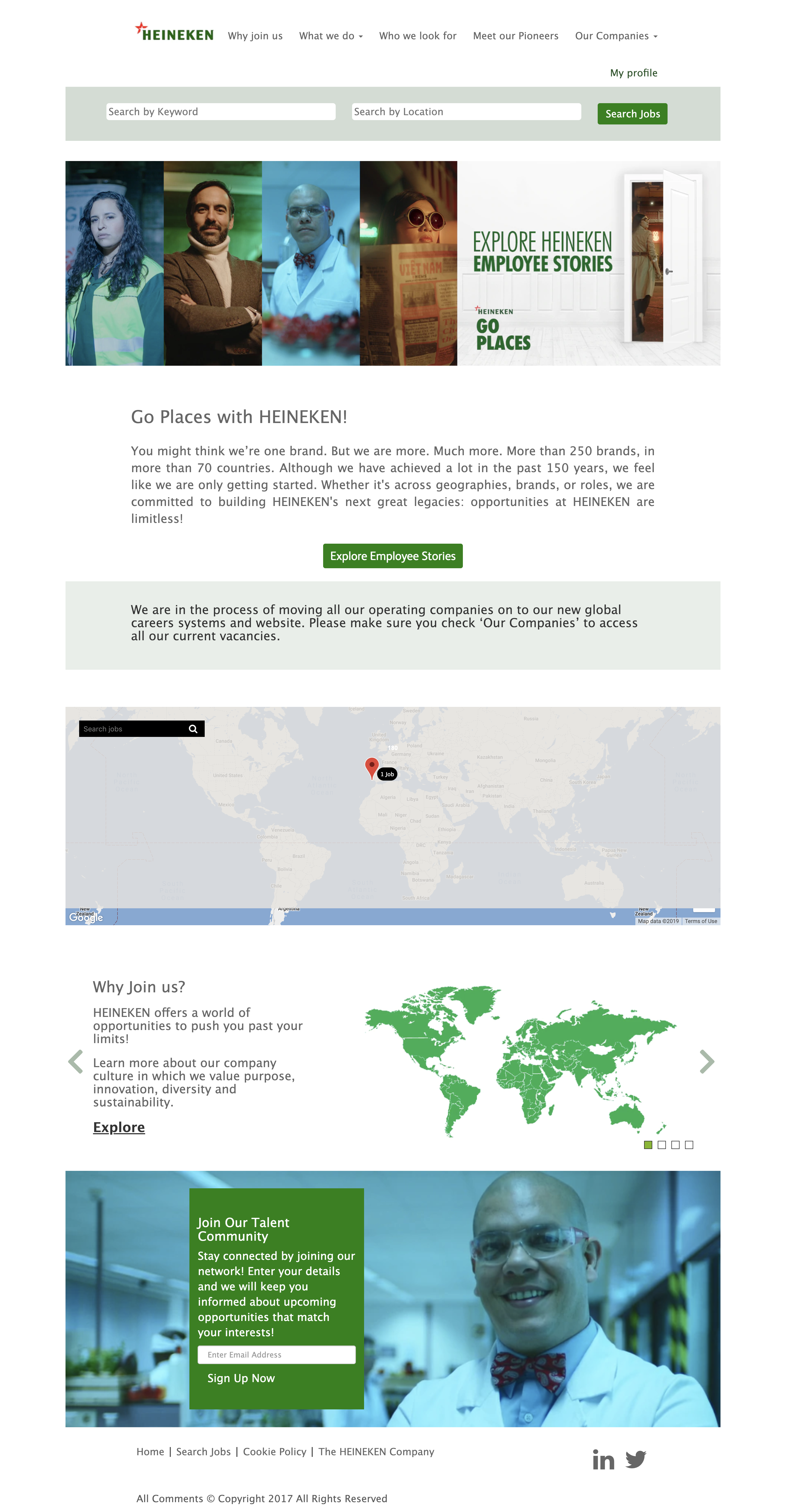
They have created an entire section devoted to their “Pioneers”, who work in different roles within the company, with short video documentaries about their working lives, like Diane here:
By putting your employees at a central role in your branding you create trust, remove obstacles and increase the engagement of your current workforce.
Pillar #3: A Well Branded Website
Your website should serve as the central hub for all employee branding.
Potential candidates will use your website to research your brand, explore your values and get their first insight into whether they want to work for you.
It is also your opportunity to:
- Share why someone should work for you.
- Set expectations of who should apply.
- Tell long form employee stories.
- Publish job openings.
In the last section, we looked at Heineken’s standalone career website. But, this can also be seamlessly incorporated into your customer-facing business website too.
One fascinating example of this we have come across is MailChimp’s:

They have created a wonderfully simple subsection of their website which caters to potential employees.
They blend their mission statement with well-written copy and employee-centric videos, to create an online environment which resonates with the top talent they want to attract.
One section which really stood out was this highlighted one here just beneath their website’s hero video:
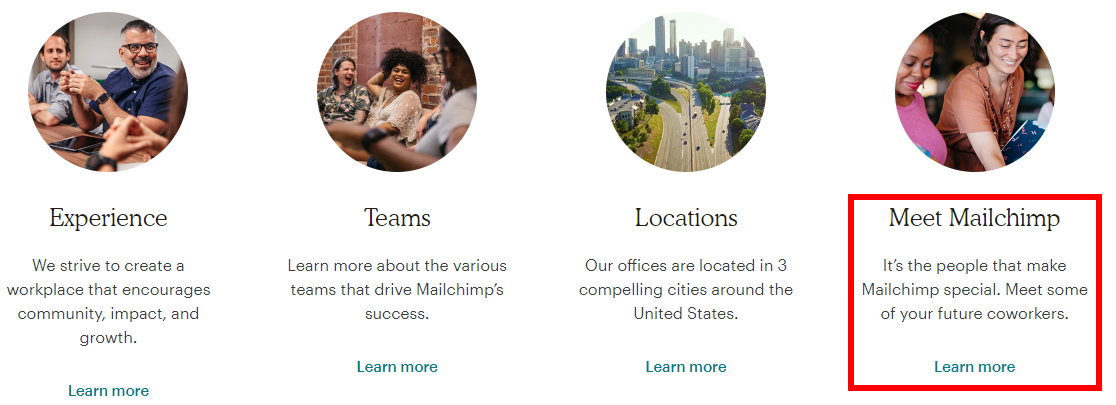
“Meet some of your future coworkers”, is not just a catchy piece of copywriting. It is a statement of their culture, ideals and what it would be like to work there.
Pillar #4: Inspiring Social Media Content
Social media plays a pivotal role in employer branding.
From the candidate’s point of view, it is a great tool to learn more about the company you want to work for, and potential candidates cite social media as the second most important tool for researching an employer’s brand, after their company website.
75% of people who recently changed job used LinkedIn to inform their decision . Proof that being able to research, interact and see third-party reviews of your brand has a strong influence.
Recruiters also see the rising importance of social media on their campaigns for companies like yours.
86% of HR professionals surveyed by ICIMIS agreed that recruitment is becoming more like marketing, and the roles of content, engagement, and outreach are increasingly important.
This comes full-circle to one of the first points we made about employer branding. In a candidate-driven market, it is important to treat and market your job openings in the same way you would your products.
Social media is the perfect tool to do that.
“If the reputation of a company’s product is its face, the talent brand is its heart and soul” – Hank Stringer
How To Build Employer Branding On Social Media
If there is one thing we “get” here at Loomly, inspired by the 4,000 marketing teams we serve on a daily basis, it is how to build a brand on social media.
In this section, we want to show you how to build that all-important social media pillar of your employer branding and show you some brands who are doing it well.
1. Choose Your Strategy
The first stage of this process is to choose your strategy.
By that we mean:
- Do you want to incorporate employer branding into your current strategy?
- Do you want to create a standalone channel for your employer branding?
There is no right or wrong answer, and it will be impacted by many different factors unique to your current business model and growth.
As a general rule of thumb, we recommend companies with fewer than 5,000 employees incorporate and companies with 5,000 or more create a standalone careers channel.
MailChimp has created a well-established employer brand by mixing job openings and workplace-related content into their normal content marketing, like here:
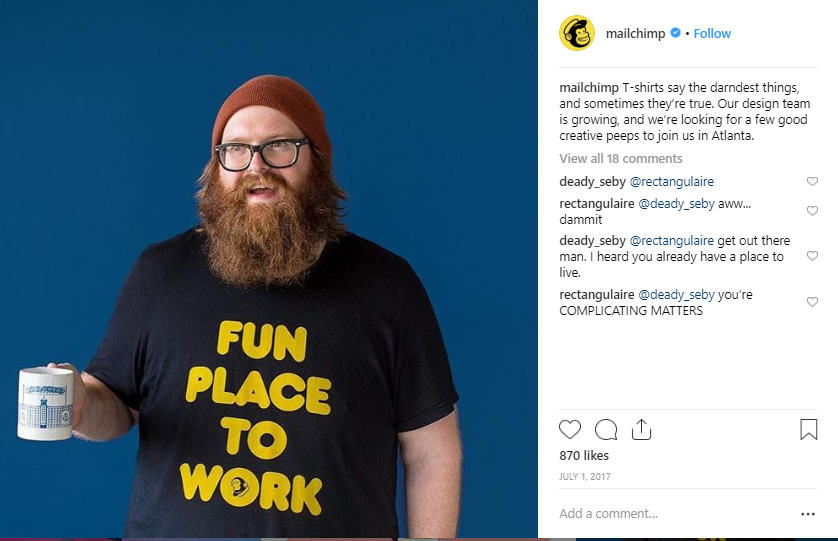
They are a medium-sized company — LinkedIn shows about 800 employees at the time of writing — with a low turnover of jobs, which means they are not on a constant recruitment drive.
On the other hand, Marriott Hotels have created their own standalone careers feeds where they talk about employees across all of their worldwide locations:
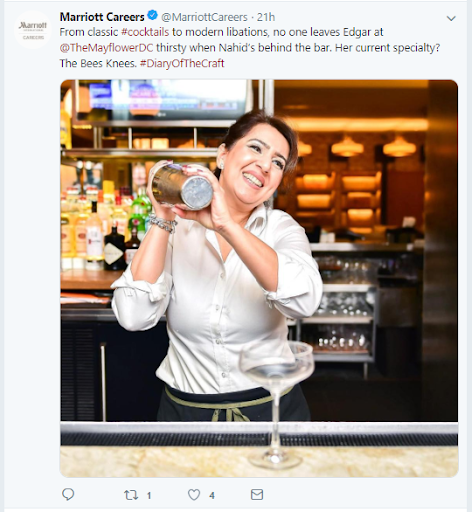
Marriott is a world-wide organization with 177,000+ employees and have a much larger marketing budget to make this happen.
The hotel industry also has a reported turnover rate of 73.8 percent which means they are on a constant recruitment drive and looking to use branding to retain more staff.
Bottom line: choose the strategy which best reflects your business, your budget and the rate at which you want to acquire employees.
2. Choose Your Platforms
With your strategy in place, the next step is to pick the correct platform to connect with your ideal potential employees.
LinkedIn will play a core role in this and, as you have already read, will be one of the go-to places for candidates to research your business and brand. So, it is worth establishing a presence there.
But not all of your ideal potential candidates will spend their time hanging out on LinkedIn, and your strategy may best be built on other platforms.
If you are looking for…
- Design-savvy 18-29-year-olds in urban areas, try Instagram.
- College educated 30-49-year-old people, try Facebook.
- Politically-minded college graduates, try Twitter.
You will need to take a deeper dive into where your demographic hangs out, but it will often be similar to those places where your potential customers spend their time too.
If in doubt, here is a quick infographic to help you guide your research:
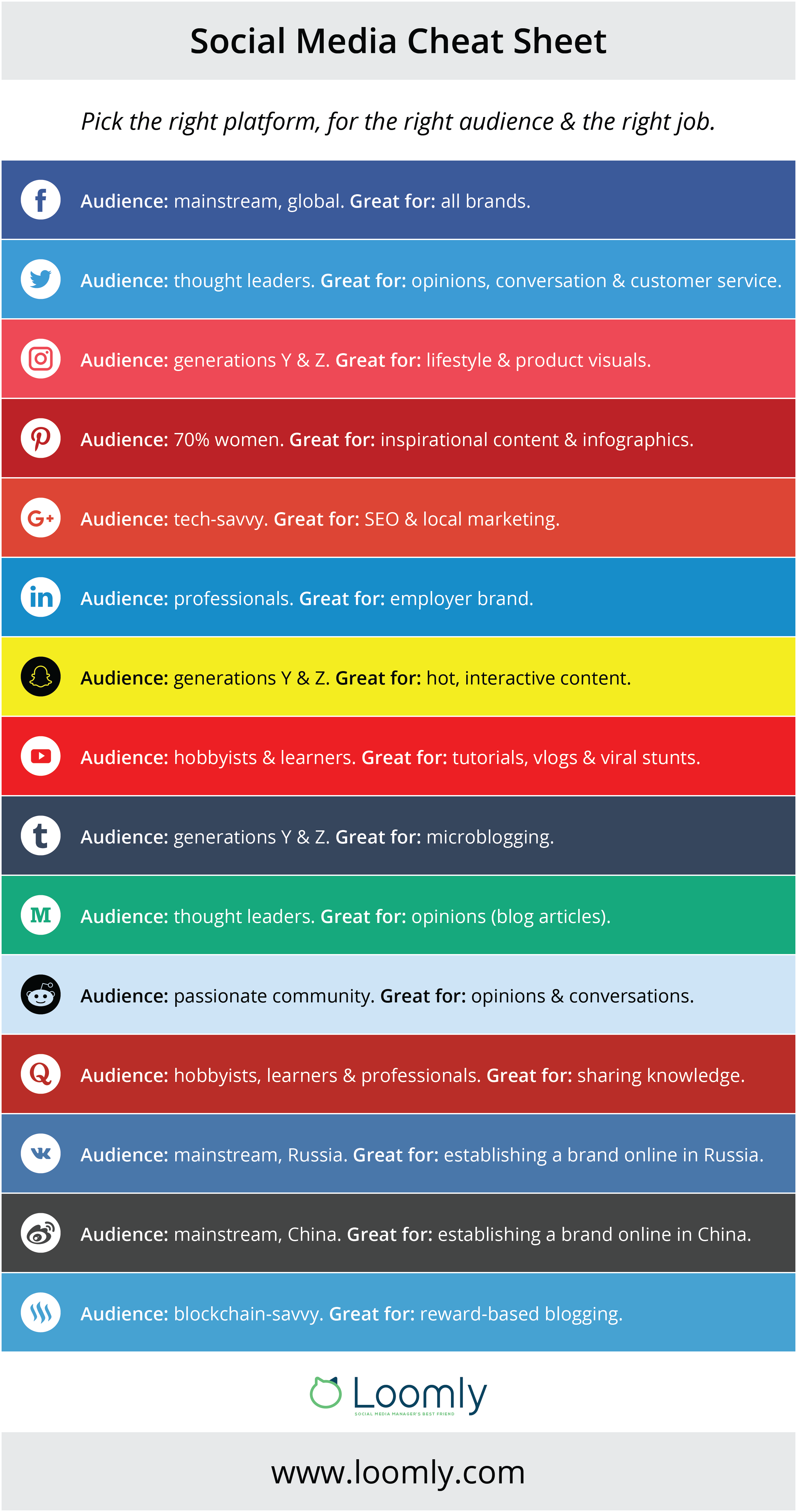
3. Tell Employee Stories
One of the key themes in this guide has been stories; especially those from your employees.
The objective of these stories is to:
- Provide insight into your workplace.
- Share employee thoughts and experiences.
- Present relevant experiences your ideal candidate may want to have.
For example, when SalesForce shared this picture on their Instagram feed, it may just look like a group of employees at the gym:
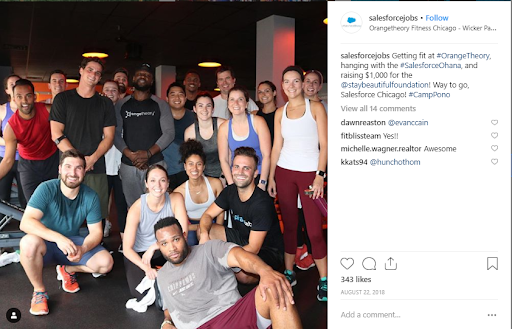
But when you look from an employee point of view, it talks about:
- Teamwork.
- Experiences.
- Not being chained to a desk all day.
- Supporting charities and communities.
- People enjoying themselves.
These may all be subtly implied, but they leave a lasting impression on the would-be candidate scrolling through their feed.
Employee stories can be found everywhere in your business, regardless of how many employees you have right now. Think of:
- Events you have hosted or attended.
- Your employee’s hobbies.
- Employee achievements (professional and personal).
- Retreats or general meetings.
- Weddings or births (where relevant).
Anything your employees are doing, which represents your brand well, can be turned into employer branding. Do not be afraid to get creative!
4. Employ The 80/20 Method
With your strategy, platforms and content ideas in place, it is time to start posting.
When you are posting with the aim of building an employer brand, it is important that not every update is, “We are hiring! Apply here…”.
Instead, you should follow the 80/20 rule:
- 80 percent of your content should be entertaining, engaging and informative
- 20 percent of your content should focus on getting candidates to apply for jobs
The rest, as they say, is up to you.
Wrapping This Up…
We hope by now you have a much better idea of what employer branding is, and how powerful it can be in transforming your business.
From your existing culture to the money you spend and how long you retain employees, all of these are improved by creating a magnetic brand around your company.
Loomly provides an all-in-one solution to help you connect, engage and interact with the potential candidates you reach on social media, allowing you:
- Grow your following with scheduled HR-approved content.
- Track, manage and replicate your highest performing posts with advanced analytics.
- See the direct impact of your posts on employer branding.
- Manage conversations with candidates across all your social platforms.
- Create headache-free workflows between all of your team members.
